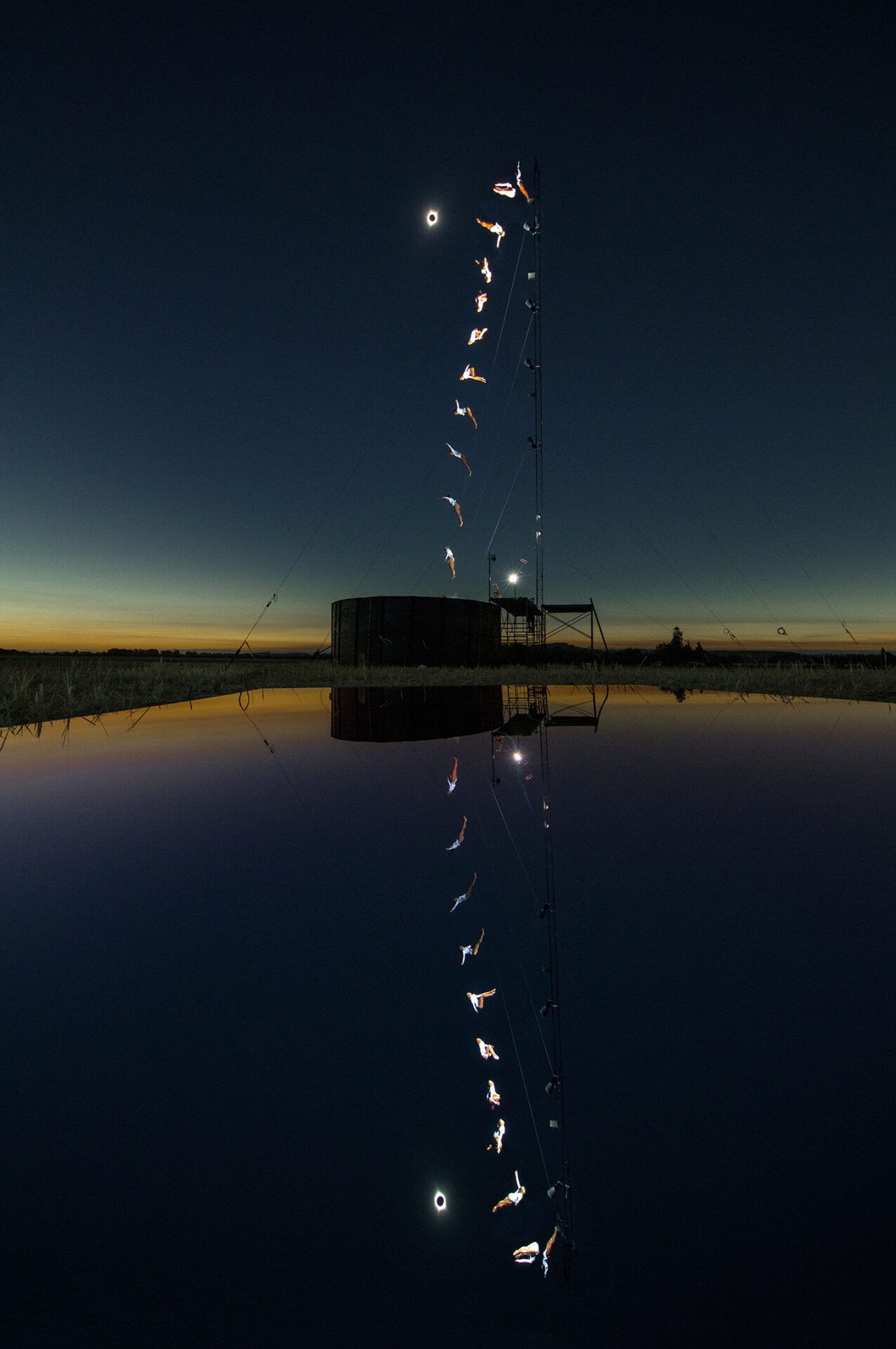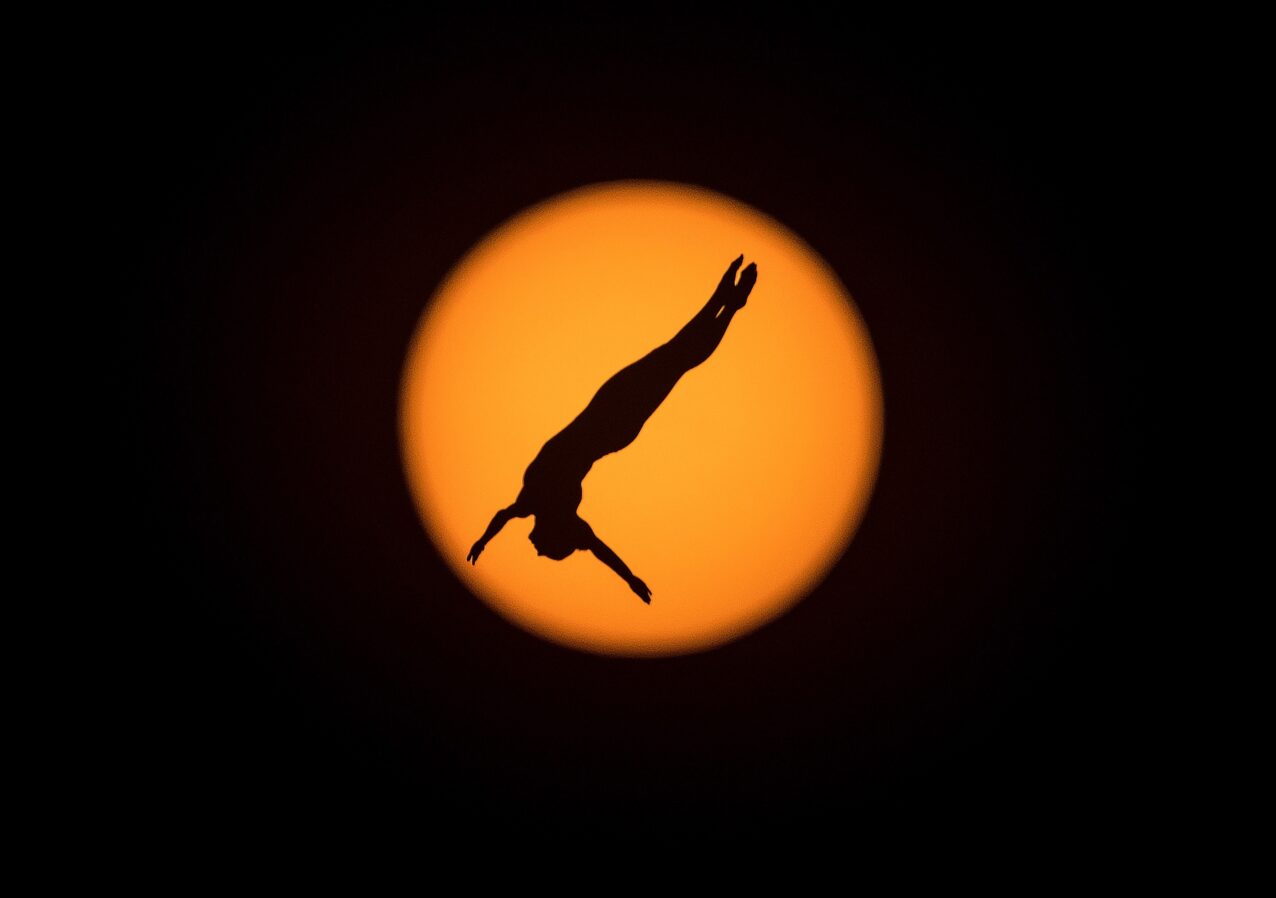
Photography + Trigonometry?
I remember half joking with my math teachers in high school “why do we need to learn this, I’m never going to use it in life?”
Fast forward to 4 months ago when Red Bull Media House calls and wants to shoot a cliff diver eclipse photo. After doing some research and discovering that the eclipse would be in totality at a very high point in the sky and it would be very difficult to line up with the divers given the long focal length needed, we had to figure out the correct angle, height and distance.

Luckily I had some help and also retained some of that knowledge and was able to pin point every position, height and angle needed for our shot list.


Preparation!
We prepared for this shoot for four months. With so many moving parts and elements that need to perfectly align, preparation was definitely the key to success. We needed the perfect location with the right amount of distance of open space and it had to be in the path of totality. We also needed a spot for the divers to dive and to make sure the divers were high enough in the air to align perfectly with the sun.

After looking all over the country at different locations, we choose a farm in McMinnville Oregon with a large wide open field and had a dive tank, (normally used in traveling carnivals and other performances) erected in the middle of the open space and had it filled with 30,000 gallons of water. (which was later used to water the very dry and dusty field.)
For the days leading up to the shoot we used a range finder to map out shooting positions and tested focal lengths, dive times, and lighting.

Hanging + controlling lights
Im not to keen on heights and although I worked in a theatre in college and I would hang lights in catwalks about 20-30 ft up. I couldn’t imagine myself climbing and hoisting lights up an 85ft tall tower. Just standing under it looking up gave me chills.
So we enlisted the help of one of the amazing dive tank crew members Clark (instagram @crazyclark1007) to help with rigging and hanging each one of the lights.
Using Kupo Grip Super Viser Clamps to mount the lights to a pole that stuck out 2ft so the light could be angled correctly.

We used the broncolor bronControl app on my phone to control the power and speed of the lights while they were up on the rig.
Test day!
The day before the eclipse we had a test shoot day with the divers to test timing and basically do a dress rehearsal of the eclipse. This was so we can see how many dives each diver could do during the different phases of the eclipse.
I knew it was going to get dark during the totality but I didn’t know how dark. So we needed to test the lighting at dusk and a little after so I could have a better idea of the camera and lighting settings before totality happened. I wouldn’t have enough time to get 4 divers off the platform, cleared, and be able to dial in settings. I needed to know before it happened so I could be ready.
High ISO
I decided on a higher ISO than normal because otherwise the background in the photo would be way to dark and there would be no context to how the sky actually looked and I couldn’t do a multiple exposure shutter bracket because I was shooting a sequence shot.
Here is the settings and equipment I used for the sequence photo.
Canon 1DX MK II
Lens (mm): 11-24 @15mm
ISO: 3200
Aperture: 5.6
Shutter: 1/160
Light power = 4 on each head

PERFECT reflection
Whats better than one Solar Eclipse?
One of the first shots I imagined when thinking of this shoot was a diver diving into a large body of water with a beautiful reflected eclipse in it.
But, because our dreams of shooting with a natural water source were crushed by science and math, I decided the next best thing was to bring in a special front coated mirror, (the type they use in large telescopes!) to give the allusion of water and provide a nice mirror image of our scene.

TOTALITY!
It was a very surreal moment once totality started and the light around us began to fade. I heard one of the divers yell that they couldn’t see the water and without missing a beat my super assistant Daniel Bray and “crazy”Clark ran over and climbed up the scaffolding on the 10ft tall staging area with large flashlights to supplement the led work lights we already had in place.
A few seconds went by and I felt my adrenaline rushing because I knew there was only 55 total seconds of totality and 15 seconds have already passed while getting the additional lighting in place. Once it was deemed safe and the divers eyes adjusted to the darkness better the first diver jumped. I fired 18 frames off during the 2.7 seconds it took to reach the water below.
I quickly checked the images on the back of my camera to make sure they had the correct lighting exposures on the diver and then, using a series of walkie talkies strapped to the ladder all the way to the top, relayed to them that they could position themselves on the 1ft in diameter platform and jump when they were ready.

The divers were all staged on different parts of the thin 85ft ladder to speed up the climbing process. As the last diver reached his arms into the sky to indicate his jump, a sliver of the sun peaked out from behind the moon and created a star burst in my camera as I fired off the last sequence shots.
After totality I couldn’t believe everything went so well. There were so many opportunities for this shoot to go wrong and such a short window of time to make it happen, but because our team took the time to look at every possible outcome and prepared for the worst we were able to come away with exactly what we sought out to do during this once in a lifetime shoot.
THANKS!
I couldn’t have done it without the support of the amazing team at Red Bull, the divers, all of our awesome crews and people helping with the setup. Canon PRO USA for the camera equipment and lenses and broncolor for the lighting, Kupo Grip for the clamps.
Time
Eclipse time – 2hrs
Totally time – 55 seconds
Shooting time during Totality from first diver – 30 seconds
85ft platform to tank – 2.7 seconds
Tower Height 85ft
Dive depth 10ft

Equipment
Canon 1DX Mark II
Canon 5DrS
11-24mm lens
70-200 2.8 IS
800mm f5.6
600mm f4
1.4x teleconverter III
2x Teleconverter III
Lighting
4 broncolor Siros L w/WIFI
2 broncolor Move packs with 1 head each
6 broncolor P45 reflectors

About Dustin Snipes
Photographer Dustin Snipes is a Los Angeles, California based portrait and sports photographer. Dustin works frequently with major national and international publications and brands including Coke-Cola, Wilson Tennis, Marriott, Spyder, Nike, Reebok, Gatorade, Red Bull, KFC, ESPN The Magazine, New York Times Magazine, Men’s Fitness, Shape, Sports Illustrated, Time, and numerous others.







